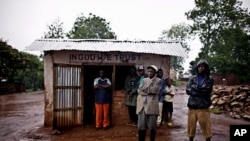The Second Congo War, the world's deadliest since World War II, began in the 1990s when civil war and genocide spilled out of Rwanda and into the eastern Democratic Republic of Congo. Now, eight years after the peace treaty, the fighting in the east continues. Although the old war lingers on, the nature of the battle is new.
Roughly the size of Western Europe, some observers say Congo has been in a constant state of crisis since 1885, when Belgium’s King Leopold II turned this land into his own personal corporation, getting rich on the backs of Congolese slaves.
The days of Leopold are remembered for mass murder, forced labor, rape, famine and piles of chopped off hands. Fidel Bafilemba, a researcher for Enough, a Washington-based advocacy organization, says violence against civilians in the mineral-rich countryside of eastern Congo continues today.
"Corruption, mismanagement, the violence - including rapes - this is King Leopold the Second’s legacy to the Congolese people," said Bafilemba.
Bafilemba and his organization are advocates against the sale of what have become known as "conflict minerals." Mining companies say there are an estimated $24 trillion worth of minerals hidden in Congolese soil, used in products as diverse as lap-tops, cell phones, food packaging and airplane engines.
From the days of Leopold, Congolese resources rarely if ever have benefited the people of Congo. Nowadays, Bafilemba says, because the mines and the roads are controlled by warring militias, the minerals pay for the conflict, and give armed groups something to fight over.
And when they fight, civilians are still subjected to forced labor and mass rapes. Children are kidnapped, villages are burned and the United Nations refugee agency says millions of people have fled their homes.
Army officials say that 80 percent of the mines in eastern Congo are still controlled by the many militias, armed groups, and rebel armies vying for power.
But the war, they say, is not about the minerals. It is a complex mixture of foreign rebel armies and local militias fighting the rebels and each other.
First, there is an internal war. Some groups are still armed in the name of political loyalties stemming from the 1960s and 70s, after the colonials left the country, and Congo became independent. Other militias come from communities locked in resource disputes.
Then, there are rebel armies originally purposed to fight the governments of neighboring Rwanda, Burundi and Uganda. Long camped out in the Congolese bush, these groups have become splintered and some also have domestic agendas.
But many militant groups in Congo have no apparent agenda. They say they are fighting for freedom, but observers say they plunder villages, terrorize the people and collect illegal taxes, simply to survive.
Congolese Army Colonel Seraphin Mirindi says much of the problem also comes from government mismanagement. Bad governance, extreme poverty and lingering political rivalries continue to fuel the conflict, he says. And as long as the Congolese countryside remains one of the poorest places on earth, people will continue to fight for resources.
Once an officer in one of Congo’s many militias, Mirindi joined the army after a 2008 power-sharing agreement. In an attempt to broker some kind of peace, the regular army and many of the militias agreed to merge.
Mirindi says the merger never really took, and the army continues to be unorganized and underpaid. When high-level militia leaders make agreements with the army, he says, it doesn’t always mean the soldiers in the bush will follow through. They may neither know, nor care what officers in the capital decide.
Army soldiers also commonly flee their posts out of sheer hunger, he says, and take their guns home, arming the already relentlessly divided population.
Without a strong national army, Mirindi says the continued presence of foreign rebel groups in eastern Congo, like the Democratic Forces for the Liberation of Rwanda, or the FDLR, makes peace in the region impossible.
The current chaos is the remnant of the Second Congo War, also known as Africa’s World War. The U.N. says the war has claimed more than five million lives, mostly through disease and famine. It began in the late 1990s, when an ethnic Tutsi-led army won neighboring Rwanda’s civil war, and Rwandan refugees poured into eastern Congo.
The war ended with a peace treaty in 2003, but the fighting in the east has never stopped.
Jason Luneno, the president of the civil society in the North Kivu province, says while there is still killing, looting, raping and the burning of homes in the countryside, it no longer looks like a typical war.
Luneno says that conflict in eastern Congo is now mainly conducted by small groups of five to ten soldiers, loosely connected with larger militias, if connected at all. There is no visible presence of the government, and state services are almost non-existent.
For Luneno, however, ending the conflict cannot just be a military quest. The army needs to be trained to fight off rebel armies, he says, but after that, communities in eastern Congo need food, schools, roads and other basic resources for all of them to get along.











